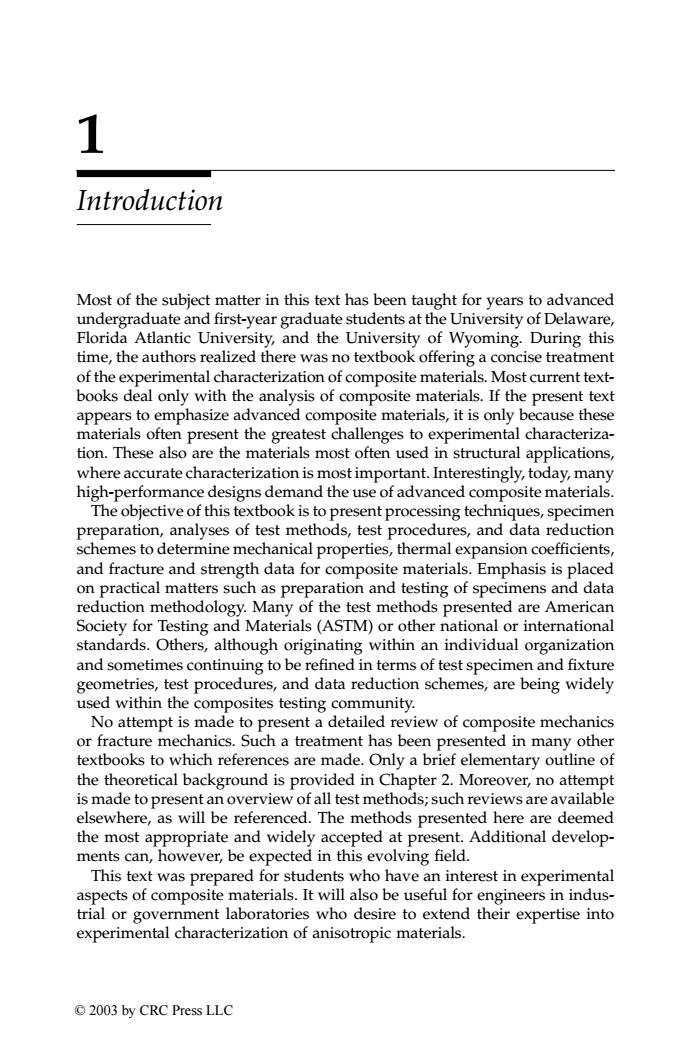正在加载图片...

1 Introduction Most of the subject matter in this text has been taught for years to advanced undergraduate and first-year graduate students at the University of Delaware, Florida Atlantic University,and the University of Wyoming.During this time,the authors realized there was no textbook offering a concise treatment of the experimental characterization of composite materials.Most current text- books deal only with the analysis of composite materials.If the present text appears to emphasize advanced composite materials,it is only because these materials often present the greatest challenges to experimental characteriza- tion.These also are the materials most often used in structural applications, where accurate characterization is most important.Interestingly,today,many high-performance designs demand the use of advanced composite materials. The objective of this textbook is to present processing techniques,specimen preparation,analyses of test methods,test procedures,and data reduction schemes to determine mechanical properties,thermal expansion coefficients, and fracture and strength data for composite materials.Emphasis is placed on practical matters such as preparation and testing of specimens and data reduction methodology.Many of the test methods presented are American Society for Testing and Materials(ASTM)or other national or international standards.Others,although originating within an individual organization and sometimes continuing to be refined in terms of test specimen and fixture geometries,test procedures,and data reduction schemes,are being widely used within the composites testing community. No attempt is made to present a detailed review of composite mechanics or fracture mechanics.Such a treatment has been presented in many other textbooks to which references are made.Only a brief elementary outline of the theoretical background is provided in Chapter 2.Moreover,no attempt is made to present an overview of all test methods;such reviews are available elsewhere,as will be referenced.The methods presented here are deemed the most appropriate and widely accepted at present.Additional develop- ments can,however,be expected in this evolving field. This text was prepared for students who have an interest in experimental aspects of composite materials.It will also be useful for engineers in indus- trial or government laboratories who desire to extend their expertise into experimental characterization of anisotropic materials. ©2003 by CRC Press LLC1 Introduction Most of the subject matter in this text has been taught for years to advanced undergraduate and first-year graduate students at the University of Delaware, Florida Atlantic University, and the University of Wyoming. During this time, the authors realized there was no textbook offering a concise treatment of the experimental characterization of composite materials. Most current textbooks deal only with the analysis of composite materials. If the present text appears to emphasize advanced composite materials, it is only because these materials often present the greatest challenges to experimental characterization. These also are the materials most often used in structural applications, where accurate characterization is most important. Interestingly, today, many high-performance designs demand the use of advanced composite materials. The objective of this textbook is to present processing techniques, specimen preparation, analyses of test methods, test procedures, and data reduction schemes to determine mechanical properties, thermal expansion coefficients, and fracture and strength data for composite materials. Emphasis is placed on practical matters such as preparation and testing of specimens and data reduction methodology. Many of the test methods presented are American Society for Testing and Materials (ASTM) or other national or international standards. Others, although originating within an individual organization and sometimes continuing to be refined in terms of test specimen and fixture geometries, test procedures, and data reduction schemes, are being widely used within the composites testing community. No attempt is made to present a detailed review of composite mechanics or fracture mechanics. Such a treatment has been presented in many other textbooks to which references are made. Only a brief elementary outline of the theoretical background is provided in Chapter 2. Moreover, no attempt is made to present an overview of all test methods; such reviews are available elsewhere, as will be referenced. The methods presented here are deemed the most appropriate and widely accepted at present. Additional developments can, however, be expected in this evolving field. This text was prepared for students who have an interest in experimental aspects of composite materials. It will also be useful for engineers in industrial or government laboratories who desire to extend their expertise into experimental characterization of anisotropic materials. TX001_ch01_Frame Page 1 Saturday, September 21, 2002 4:47 AM © 2003 by CRC Press LLC